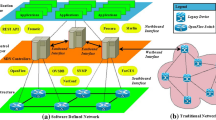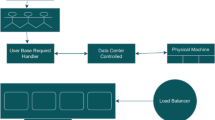In this paper, we propose a novel architecture for the admission control module of a Bandwidth Broker entity that aims at achieving a satisfactory balance between maximizing the resource utilization for the managed network and minimizing the overhead of the module. We also describe, analyze and evaluate mechanisms which aim at solving the additional problems of fairly prioritizing resubmitted requests and efficiently handling requests which do not specify ending times. We use the well known network simulator ns-2, as well as a custom simulation environment in order to study the performance characteristics of the proposed mechanisms and compare them with various alternatives for the admission control module of a Bandwidth Broker. We provide the results of the experimental evaluations and the conclusions they lead us to for the relative importance of the proposed solution and the various alternatives, their advantages and drawbacks, and the environments for which each one is best suited.











Similar content being viewed by others
REFERENCES
RFC 2475 “An Architecture for Differentiated Services,” S. Blake, D. Black, M. Carlson, E. Davies, Z. Wang, W. Weiss, December 1998.
RFC 2638 “A Two-bit Differentiated Services Architecture for the Internet,” K. Nichols, V. Jackobson, L. Zhang, July 1999.
“QBone Bandwidth Broker Architecture,” QBone Signaling Design Team, http://qbone.internet2.edu/bb/bboutline2.html (Accessed May 2006).
“Bandwidth Broker Implementation,” Information and Technology Telecommunication Centre, University of Kansas, http://www.ittc.ukans.edu/∼kdrao/BB/ (Accessed September 2006).
T. Braun and G. Stattenberger, Performance of a Bandwidth Broker for DiffServ Networks, Kommunikation in verteilten Systemen (KiVS03), Leipzig, Germany, March 25–28, 2003.
J. Ogawa, A. Terzis, S. Tsui, L. Wang, and L. Zhang, A Prototype Implementation of the Two-Tier Architecture for Differentiated Services, RTAS99 Vancouver, Canada.
L. Wolf, and R. Steinmetz, Concepts for Resource Reservation in Advance, The Journal of Multimedia Tools and Applications, Special Issue on State of the Art in Multimedia Computing, pp. 255–278, May 1997.
A. Gupta, Advance Reservation in Real-Time Communication Services, In: Proceedings of the IEEE 22nd Annual Conference on Local Computer Networks (LCN, 1997), 1997.
D. Ferrari, A. Gupta, and G. Ventre, Distributed advance reservation of real-time connections, In: Proceedings of the Fifth International Workshop on Network and Operating System Support for Digital Audio and Video, (NOSSDAV`95), Durham, NH, pp. 16–27, April 1995.
M. Degermark, T. Kohler, S. Pink, and O. Schelen, Advance Reservations for Predictive Service, In: Proceedings from 5th Workshop on Network and Operating System Support for Digital Audio and Video (NOSSDAV’95), Durham, New Hampshire, pp 3–14, April 1995.
J. Hwang, S. J. Chapin, H. A. Mantar, I. T. Okumus, Rajeesh Revuru, and Aseem Salama, An Implementation Study of a Dynamic Inter-Domain Bandwidth Management Platform in Diffserv Networks, In: Proceedings of the 9th IEEE/IFIP Network Operations and Management Symposium (NOMS 2004), Seoul, Korea, April 2004.
K. Wong and K. L. E. Law, ABB: Active Bandwidth Broker In: Proc. SPIE ITCom 2001, Vol. 4523, pp. 253–262, Denver, August 2001.
N. Blefari-Melazzi, J. N. Daigle, and N. Femminella, Stateless Admission Control for QoS Provisioning for VoIP in a DiffServ Domain, 18th International Teletraffic Congress, Berlin, Germany, September 2003.
M. Menth, S. Gehrsitz, and J. Milbrandt, Fair Assignement of Efficient Network Admission Control Budgets, 18th International Teletraffic Congress, Berlin, Germany, September 2003.
C. Brandauer, W. Burakowski, M. Dabrowski, B. Koch, and H. Tarasiuk, AC algorithms in Aquila QoS IP network, 2nd Polish-German Teletraffic Symposium PGTS 2002, Gdansk, Poland, September 2002.
M. Dabrowski, A. Beben, and W. Burakowski, On Inter-Domain Admission Control Supported by Measurements in Multi-domain IP QoS Network, Inter-Domain Performance and Simulation IPS 2004, Budapest, Hungary, March 2004.
S. Machiraju, M. Seshadri, and I. Stoica, A Scalable and Robust Solution for Bandwidth Allocation, Technical Report UCB//CSD02 -1176, University of California at Berkeley, 2002.
A. Greenberg, R. Srikant, and W. Whitt, Resource Sharing for Book-Ahead and Instantaneous-Request Calls, IEEE/ACM Transactions on Networking, vol 7, No. 1, pp. 10–22, February 1999.
C. Chhabra, T. Erlebach, B. Stiller, and D. Vukadinovic, Price-based Call Admission Control in a Single DiffServ Domain, TIK-Report Nr. 135, May 2002.
C. Bouras, V. Kapoulas, G. Pantziou, and P. Spirakis, Competitive Video On Demand Schedulers for Popular Movies, Discrete Applied Mathematics, Vol. 129, pp. 49–61, 2003.
E. Mykoniati, C. Charalampous, P. Georgatsos, T. Damilatis, D. Goderis, P. Trimintzios, G. Pavlou, and D. Griffin, Admission Control for Providing QoS in DiffServ IP Networks: The TEQUILA Approach, IEEE Communications Magazine, Vol. 41 No. 1, 2003.
M. Menth, Efficient Admission Control and Routing for Resilient Communication Networks, PhD thesis, University of Würzburg, Faculty of Computer Science, Am Hubland, July 2004 http://opus.bibliothek.uni-wuerzburg.de/opus/volltexte/2004/994/pdf/Menth04.pdf (Accessed September 2006).
R. Boutaba, W. Szeto, and Y. Iraqi, DORA: Efficient Routing for MPLS Traffic Engineering, Journal of Network and Systems Management, Special Issue on Internet Traffic Engineering and Management, Vol. 10 No. 3, pp. 309–325, 2002.
European Telecommunications Standards Institute (ETSI), http://www.etsi.org/ (Accessed September 2006).
ETSI ES 282 003 V1.1.1. Telecommunications and Internet converged Services and Protocols for Advanced Networking (TISPAN); Resource and Admission Control Sub-system (RACS); Functional Architecture, European Telecommunications Standards Institute, 2006.
C. Gallon, Quality of Service For Next Generation VoIP Networks, MSF-TR-QoS-FINAL.
C. Gallon, and Olov Schelén, Bandwidth Management in Next Generation Packet Networks, MSF Technical Report, MSF-TR-ARCH-005-FINAL, August 2005.
3GPP TS 23.207 v6.4.0 3rd Generation Partnership Project; Technical Specification Group Services And System Aspects; End-to-end Quality of Service (QoS) concept and architecture (Release 6).
N. Duffield, P. Goyal, A. Greenberg, P. P. Mishra, K. K. Ramakrishnan, and J. E. van der Merive, Flexible Model for Resource Management in Virtual Private Networks, SIGCOMM, pp. 95–108, 1999.
R. J. Gibbens and P. J. Hunt, Effective Bandwidths for the Multi-Type UAS Channel, Queueing Systems, Vol. 9, pp. 17–28, 1991.
R. Guerin, H. Ahmadi, and M. Naghshineh, Equivalent capacity and its application to bandwidth allocation in High-Speed Networks, IEEE J. Select. Areas Commun, Vol. 9, pp. 968–981, 1991.
F.P. Kelly, Effective Bandwidths at Multi-Class Queues, Queueing Systems, Vol. 9, pp. 5–16, 1991.
V. Vazirani, Approximation Algorithms, Springer-Verlag, 2001.
B. Lee, W.-K. Woo, C.-K. Yeo, T.-M. Lim, B.-H. Lim, Y. He, and J. Song, Secure Communications between Bandwidth Brokers, Operating Systems Review, Vol. 38, no. 1, pp. 43–57, 2004.
V. Sander, The security Environment of SIBBS, http://qbone.internet2.edu/bb/SIBBS-SEC.doc, June 2000.
V. Sander, W. Adamson, I. Foster, and A. Roy, End-to-End Provision of Policy Information for Network QoS, Proceedings of the 10th International Symposium on High Performance Distributed Computing, pp. 115–126, 2001.
Pat Beirne illustration, 5/1/06, based on an original graph created by Jeremy Kemp, 2/9/05, http://en.wikipedia.org/wiki/Image:Standard_deviation_diagram.png (Accessed September 2006).
The Network Simulator – ns-2, http://www.isi.edu/nsnam/ns/ (Accessed September 2006).
www.random.org.
C. Bouras, and K. Stamos, An Adaptive Admission Control Algorithm for Bandwidth Brokers, 3rd IEEE International Symposium on Network Computing and Applications (NCA04), Cambridge, MA, USA, pp. 243–250, August 30 – September 1 2004.
P. L’Ecuyer, Good Parameters and Implementations for Combined Multiple Recursive Random Number Generators, Operations Research, Vol. 47, no. 1, 159–164, 1999.
http://ru6.cti.gr/ru6/ns_home.php (Accessed September 2006).
Author information
Authors and Affiliations
Corresponding author
Additional information
Christos Bouras obtained his Diploma and PhD from the Computer Science and Engineering Department of Patras University (Greece), where he is currently an Associate Professor. He is also a scientific advisor of Research Unit 6 in Research Academic Computer Technology Institute (CTI), Patras, Greece.
Kostas Stamos obtained his Diploma and Master Degree from the Computer Engineering and Informatics Department of Patras University. He is currently a PhD candidate at the same department and is working at Research Unit 6 in Research Academic Computer Technology Institute (CTI), Patras, Greece.
Rights and permissions
About this article
Cite this article
Bouras, C., Stamos, K. Performance Analysis of Adaptive Admission Control Algorithms for Bandwidth Brokers. J Netw Syst Manage 15, 191–218 (2007). https://doi.org/10.1007/s10922-007-9059-8
Published:
Issue Date:
DOI: https://doi.org/10.1007/s10922-007-9059-8




